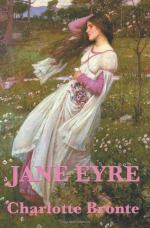“I like it,” she answered, after a pause of a second or two, during which she examined me.
“What is it about?” I continued. I hardly know where I found the hardihood thus to open a conversation with a stranger; the step was contrary to my nature and habits: but I think her occupation touched a chord of sympathy somewhere; for I too liked reading, though of a frivolous and childish kind; I could not digest or comprehend the serious or substantial.
“You may look at it,” replied the girl, offering me the book.
I did so; a brief examination convinced me that the contents were less taking than the title: “Rasselas” looked dull to my trifling taste; I saw nothing about fairies, nothing about genii; no bright variety seemed spread over the closely-printed pages. I returned it to her; she received it quietly, and without saying anything she was about to relapse into her former studious mood: again I ventured to disturb her —
“Can you tell me what the writing on that stone over the door means? What is Lowood Institution?”
“This house where you are come to live.”
“And why do they call it Institution? Is it in any way different from other schools?”
“It is partly a charity-school: you and I, and all the rest of us, are charity-children. I suppose you are an orphan: are not either your father or your mother dead?”
“Both died before I can remember.”
“Well, all the girls here have lost either one or both parents, and this is called an institution for educating orphans.”
“Do we pay no money? Do they keep us for nothing?”
“We pay, or our friends pay, fifteen pounds a year for each.”
“Then why do they call us charity-children?”
“Because fifteen pounds is not enough for board and teaching, and the deficiency is supplied by subscription.”
“Who subscribes?”
“Different benevolent-minded ladies and gentlemen in this neighbourhood and in London.”
“Who was Naomi Brocklehurst?”
“The lady who built the new part of this house as that tablet records, and whose son overlooks and directs everything here.”
“Why?”
“Because he is treasurer and manager of the establishment.”
“Then this house does not belong to that tall lady who wears a watch, and who said we were to have some bread and cheese?”
“To Miss Temple? Oh, no! I wish it did: she has to answer to Mr. Brocklehurst for all she does. Mr. Brocklehurst buys all our food and all our clothes.”
“Does he live here?”
“No — two miles off, at a large hall.”
“Is he a good man?”
“He is a clergyman, and is said to do a great deal of good.”
“Did you say that tall lady was called Miss Temple?”
“Yes.”
“And what are the other teachers called?”
“The one with red cheeks is called Miss Smith; she attends to the work, and cuts out — for we make our own clothes, our frocks, and pelisses, and everything; the little one with black hair is Miss Scatcherd; she teaches history and grammar, and hears the second class repetitions; and the one who wears a shawl, and has a pocket-handkerchief tied to her side with a yellow ribband, is Madame Pierrot: she comes from Lisle, in France, and teaches French.”




